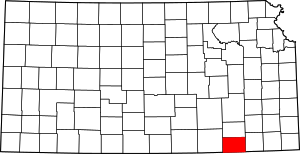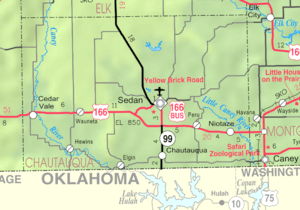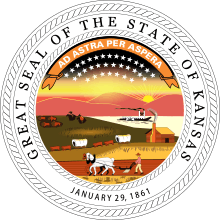Chautauqua County, Kansas
Chautauqua County (county code CQ) is a county located in Southeast Kansas. As of the 2010 census, the county population was 3,669.[1] Its county seat and most populous city is Sedan.[2] Chautauqua County is named for Chautauqua County, New York, the birthplace of Edward Jaquins, a Kansas politician who was instrumental in getting the county established.[3]
Chautauqua County | |
|---|---|
 Downtown Sedan, Kansas. | |
 Location within the U.S. state of Kansas | |
 Kansas's location within the U.S. | |
| Coordinates: | |
| Country | |
| State | |
| Founded | March 25, 1875 |
| Named for | Chautauqua County, New York |
| Seat | Sedan |
| Largest city | Sedan |
| Area | |
| • Total | 645 sq mi (1,670 km2) |
| • Land | 639 sq mi (1,660 km2) |
| • Water | 5.9 sq mi (15 km2) 0.9%% |
| Population | |
| • Estimate (2018) | 3,309 |
| • Density | 5.7/sq mi (2.2/km2) |
| Time zone | UTC−6 (Central) |
| • Summer (DST) | UTC−5 (CDT) |
| Area code | 620 |
| Congressional district | 4th |
| Website | chautauquacountyks.com |
History
Early history
For many millennia, the Great Plains of North America was inhabited by nomadic Native Americans. From the 16th century to 18th century, the Kingdom of France claimed ownership of large parts of North America. In 1762, after the French and Indian War, France secretly ceded New France to Spain, per the Treaty of Fontainebleau.
19th century
In 1802, Spain returned most of the land to France, but keeping title to about 7,500 square miles. In 1803, most of the land for modern day Kansas was acquired by the United States from France as part of the 828,000 square mile Louisiana Purchase for 2.83 cents per acre.
In 1854, the Kansas Territory was organized, then in 1861 Kansas became the 34th U.S. state. Chautauqua County was created by an act of the Kansas legislature on June 1, 1875 by the division of Howard County into Elk County (the northern half) and Chautauqua County (the southern half). At the time of its creation, the county's population was about 7,400.
Geography
According to the U.S. Census Bureau, the county has a total area of 645 square miles (1,670 km2), of which 639 square miles (1,660 km2) is land and 5.9 square miles (15 km2) (0.9%) is water.[4]
Adjacent counties
- Elk County (north)
- Montgomery County (east)
- Washington County, Oklahoma (southeast)
- Osage County, Oklahoma (south)
- Cowley County (west)
Major highways
Demographics
| Historical population | |||
|---|---|---|---|
| Census | Pop. | %± | |
| 1880 | 11,072 | — | |
| 1890 | 12,297 | 11.1% | |
| 1900 | 11,804 | −4.0% | |
| 1910 | 11,429 | −3.2% | |
| 1920 | 11,598 | 1.5% | |
| 1930 | 10,352 | −10.7% | |
| 1940 | 9,233 | −10.8% | |
| 1950 | 7,376 | −20.1% | |
| 1960 | 5,956 | −19.3% | |
| 1970 | 4,642 | −22.1% | |
| 1980 | 5,016 | 8.1% | |
| 1990 | 4,407 | −12.1% | |
| 2000 | 4,359 | −1.1% | |
| 2010 | 3,669 | −15.8% | |
| Est. 2018 | 3,309 | [7] | −9.8% |
| U.S. Decennial Census[8] 1790-1960[9] 1900-1990[10] 1990-2000[11] 2010-2016[1] | |||
As of the 2000 census,[12] there were 4,359 people, 1,796 households, and 1,235 families residing in the county. The population density was 7 people per square mile (3/km2). There were 2,169 housing units at an average density of 3 per square mile (1/km2). The racial makeup of the county was 93.83% White, 0.30% Black or African American, 3.58% Native American, 0.07% Asian, 0.05% Pacific Islander, 0.34% from other races, and 1.84% from two or more races. Hispanic or Latino of any race were 1.35% of the population.
There were 1,796 households, out of which 26.20% had children under the age of 18 living with them, 57.30% were married couples living together, 7.90% had a female householder with no husband present, and 31.20% were non-families. 29.40% of all households were made up of individuals, and 16.40% had someone living alone who was 65 years of age or older. The average household size was 2.34 and the average family size was 2.87.
In the county, the population was spread out, with 23.40% under the age of 18, 6.10% from 18 to 24, 20.90% from 25 to 44, 25.20% from 45 to 64, and 24.30% who were 65 years of age or older. The median age was 45 years. For every 100 females there were 93.60 males. For every 100 females age 18 and over, there were 91.20 males.
The median income for a household in the county was $28,717, and the median income for a family was $33,871. Males had a median income of $25,083 versus $21,346 for females. The per capita income for the county was $16,280. About 9.00% of families and 12.20% of the population were below the poverty line, including 15.80% of those under age 18 and 10.60% of those age 65 or over.
Government
Presidential elections
| Year | Republican | Democratic | Third Parties |
|---|---|---|---|
| 2016 | 83.5% 1,236 | 13.3% 197 | 3.2% 48 |
| 2012 | 80.0% 1,304 | 17.2% 280 | 2.8% 46 |
| 2008 | 76.6% 1,418 | 21.7% 401 | 1.8% 33 |
| 2004 | 78.0% 1,529 | 20.6% 404 | 1.4% 27 |
| 2000 | 71.7% 1,347 | 23.6% 443 | 4.8% 90 |
| 1996 | 58.3% 1,142 | 29.0% 568 | 12.8% 250 |
| 1992 | 41.2% 853 | 28.9% 598 | 30.0% 622 |
| 1988 | 64.5% 1,247 | 34.2% 661 | 1.3% 26 |
| 1984 | 76.6% 1,688 | 22.5% 497 | 0.9% 20 |
| 1980 | 71.6% 1,566 | 24.8% 543 | 3.6% 78 |
| 1976 | 55.8% 1,159 | 41.7% 866 | 2.6% 53 |
| 1972 | 78.0% 1,546 | 19.1% 378 | 2.9% 58 |
| 1968 | 65.5% 1,537 | 20.4% 478 | 14.1% 331 |
| 1964 | 55.4% 1,463 | 44.1% 1,163 | 0.5% 14 |
| 1960 | 70.5% 2,160 | 28.9% 885 | 0.6% 17 |
| 1956 | 70.9% 2,180 | 28.8% 887 | 0.3% 10 |
| 1952 | 74.8% 2,542 | 24.6% 837 | 0.6% 21 |
| 1948 | 59.3% 1,925 | 38.9% 1,261 | 1.8% 58 |
| 1944 | 67.4% 2,305 | 32.3% 1,106 | 0.3% 10 |
| 1940 | 62.7% 2,888 | 36.5% 1,679 | 0.9% 39 |
| 1936 | 54.5% 2,506 | 45.2% 2,080 | 0.3% 13 |
| 1932 | 43.4% 1,893 | 51.9% 2,263 | 4.7% 204 |
| 1928 | 76.0% 3,303 | 21.7% 944 | 2.3% 101 |
| 1924 | 60.0% 2,439 | 26.7% 1,087 | 13.3% 540 |
| 1920 | 68.6% 2,539 | 25.3% 936 | 6.1% 227 |
| 1916 | 49.7% 2,085 | 41.4% 1,737 | 8.9% 374 |
| 1912 | 31.4% 818 | 28.8% 752 | 39.8% 1,039[lower-alpha 1] |
| 1908 | 60.2% 1,689 | 34.1% 958 | 5.7% 159 |
| 1904 | 67.5% 2,033 | 22.6% 681 | 9.9% 299 |
| 1900 | 55.5% 1,618 | 43.9% 1,280 | 0.7% 19 |
| 1896 | 50.9% 1,359 | 48.5% 1,293 | 0.6% 17 |
| 1892 | 52.0% 1,408 | 48.0% 1,298 | |
| 1888 | 57.6% 1,590 | 25.1% 694 | 17.3% 478 |
Chautauqua is an overwhelmingly Republican county. The only Republican to ever lose the county has been Herbert Hoover during his landslide 1932 election defeat when he carried fewer than fifty counties west of the Mississippi. Apart from never-Democratic, historically Yankee Doniphan County, it was the only Kansas county to give incumbent President William Howard Taft a plurality in 1912. The last Democrat to pass thirty percent of the county's vote was Michael Dukakis in 1988, and in 2016 Hillary Clinton received merely thirteen percent.
Laws
Although the Kansas Constitution was amended in 1986 to allow the sale of alcoholic liquor by the individual drink with the approval of voters, Chautauqua County remained a prohibition, or "dry", county, until 2008, when a county wide ballot measure was approved to allow individual liquor sales with a 30 percent food requirement[14]
Education
Unified school districts
Communities

Cities
Unincorporated communities
Townships
Chautauqua County is divided into twelve townships. None of the cities within the county are considered governmentally independent, and all figures for the townships include those of the cities. In the following table, the population center is the largest city (or cities) included in that township's population total, if it is of a significant size.
| Township | FIPS | Population center |
Population | Population density /km2 (/sq mi) |
Land area km2 (sq mi) | Water area km2 (sq mi) | Water % | Geographic coordinates |
|---|---|---|---|---|---|---|---|---|
| Belleville | 05575 | 675 | 4 (11) | 155 (60) | 0 (0) | 0.14% | 37°3′50″N 96°7′48″W | |
| Caneyville | 10425 | 88 | 1 (2) | 144 (55) | 1 (0) | 0.38% | 37°15′23″N 96°27′27″W | |
| Center | 11575 | 75 | 1 (1) | 144 (56) | 1 (0) | 0.80% | 37°15′28″N 96°18′31″W | |
| Harrison | 30275 | 114 | 1 (2) | 142 (55) | 0 (0) | 0.14% | 37°4′3″N 96°26′32″W | |
| Hendricks | 31300 | 179 | 1 (3) | 142 (55) | 0 (0) | 0.05% | 37°1′12″N 96°18′42″W | |
| Jefferson | 35125 | Cedar Vale | 834 | 6 (15) | 144 (56) | 1 (0) | 0.45% | 37°6′45″N 96°29′12″W |
| Lafayette | 37650 | 65 | 0 (1) | 154 (59) | 2 (1) | 1.40% | 37°15′36″N 96°10′20″W | |
| Little Caney | 41525 | 353 | 3 (8) | 117 (45) | 0 (0) | 0.31% | 37°3′51″N 96°1′5″W | |
| Salt Creek | 62775 | 123 | 1 (3) | 127 (49) | 0 (0) | 0.34% | 37°15′13″N 96°1′34″W | |
| Sedan | 63775 | Sedan | 1,660 | 13 (34) | 128 (49) | 1 (0) | 0.65% | 37°7′50″N 96°11′6″W |
| Summit | 69025 | 106 | 1 (2) | 144 (56) | 1 (0) | 0.40% | 37°8′17″N 96°19′53″W | |
| Washington | 75550 | 87 | 1 (2) | 121 (47) | 1 (0) | 0.71% | 37°7′41″N 96°0′52″W | |
| Sources: "Census 2000 U.S. Gazetteer Files". U.S. Census Bureau, Geography Division. Archived from the original on 2002-08-02. | ||||||||
See also
|
|
References
- "State & County QuickFacts". United States Census Bureau. Archived from the original on July 8, 2011. Retrieved July 22, 2014.
- "Find a County". National Association of Counties. Archived from the original on 2011-05-31. Retrieved 2011-06-07.
- "Chautauqua County, Kansas". Kansas Historical Society. Retrieved 6 June 2014.
- "US Gazetteer files: 2010, 2000, and 1990". United States Census Bureau. 2011-02-12. Retrieved 2011-04-23.
- National Atlas Archived December 5, 2008, at the Wayback Machine
- "U.S. Census Bureau TIGER shape files". Archived from the original on 2017-05-23. Retrieved 2017-12-05.
- "Population and Housing Unit Estimates". Retrieved December 23, 2019.
- "U.S. Decennial Census". United States Census Bureau. Retrieved July 22, 2014.
- "Historical Census Browser". University of Virginia Library. Retrieved July 22, 2014.
- "Population of Counties by Decennial Census: 1900 to 1990". United States Census Bureau. Retrieved July 22, 2014.
- "Census 2000 PHC-T-4. Ranking Tables for Counties: 1990 and 2000" (PDF). United States Census Bureau. Retrieved July 22, 2014.
- "U.S. Census website". United States Census Bureau. Retrieved 2008-01-31.
- http://uselectionatlas.org/RESULTS
- "Map of Wet and Dry Counties". Alcoholic Beverage Control, Kansas Department of Revenue. November 2006. Archived from the original on 2007-10-08. Retrieved 2007-12-26.
- Rydjord, John (1972). Kansas Place-Names. University of Oklahoma Press, Norman, Oklahoma. pp. 250–251. ISBN 0-8061-0994-7.
- "Kansas Post Offices, 1828-1961 (archived)". Kansas Historical Society. Archived from the original on October 9, 2013. Retrieved 6 June 2014.
- Rydjord, John (1972). Kansas Place-Names. University of Oklahoma Press, Norman, Oklahoma. p. 493. ISBN 0-8061-0994-7.
- Rydjord, John (1972). Kansas Place-Names. University of Oklahoma Press, Norman, Oklahoma. p. 96. ISBN 0-8061-0994-7.
- Notes
- Comprising 762 votes for Progressive Theodore Roosevelt and 277 for Socialist Eugene Debs.
Further reading
- Handbook of Elk and Chautauqua Counties, Kansas; C.S. Burch Publishing Co; 24 pages; 1886.
- Standard Atlas of Chautauqua County, Kansas; Geo. A. Ogle & Co; 66 pages; 1921.
- Standard Atlas of Chautauqua County, Kansas; Geo. A. Ogle & Co; 32 pages; 1903.

